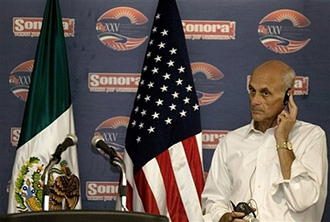 |
 |
 |
 News from Around the Americas | October 2007 News from Around the Americas | October 2007  
Chertoff Defends Southwest Border Fence
 Eileen Sullivan - Associated Press Eileen Sullivan - Associated Press
go to original


| | U.S. Homeland Security Secretary Michael Chertoff listens questions at a news conference at the closing of the Mexico U.S. Border Conference in Puerto Penasco, Mexico, Friday, Sept. 28, 2007. (AP/Guillermo Arias) |
Washington - Homeland Security Secretary Michael Chertoff on Monday defended the construction of a fence along the southwest border, saying it's actually better for the environment than what happens when people illegally cross the U.S.-Mexico line.

"Illegal migrants really degrade the environment. I've seen pictures of human waste, garbage, discarded bottles and other human artifact in pristine areas," Chertoff said in a telephone interview with The Associated Press. "And believe me, that is the worst thing you can do to the environment."

To curb illegal immigration, the U.S. government plans to complete 370 miles of fencing and put 200 miles of vehicle barriers on the southwest border by the end of 2008. But this has brought complaints that the fence and barriers are harmful to the environment.

Chertoff said the department exceeded its goal to complete 150 miles of fencing along the Mexican border by the end of the 2007 fiscal year, which was Sunday.

Last month, Chertoff said there was glitch in a "virtual fence" — a 28-mile stretch of surveillance technologies near the border southwest of Tucson — and he would not pay the contractor, Boeing Co., until that was resolved. The technologies were not all working together so that images caught on radar could be sent to a Border Patrol agent monitoring the system, Chertoff said Monday.

But he also said the problem "appears to be getting fixed" and Chertoff said the program will undergo its final testing phase over the next 30 days.

"I've seen this kind of system work in other settings, so it's not a novel or a technologically difficult task," the secretary said Monday. "But because it is complicated, and because it's a demanding environment, we just weren't comfortable that we were happy with the way it was working." | 
 | |
 |



